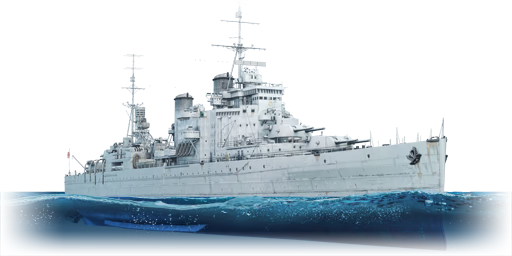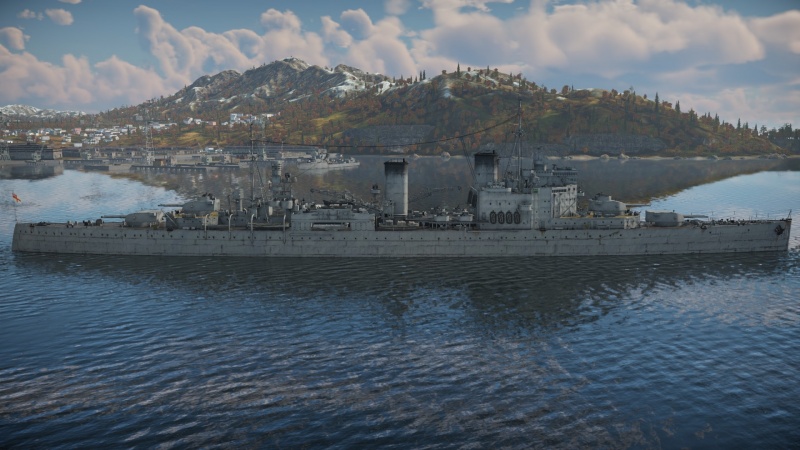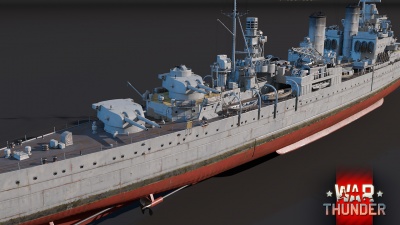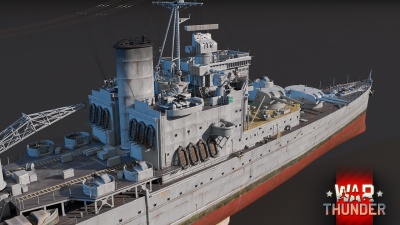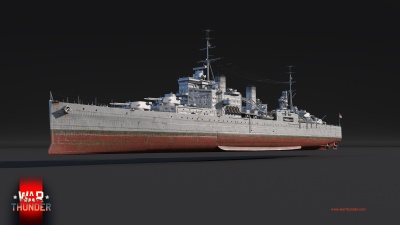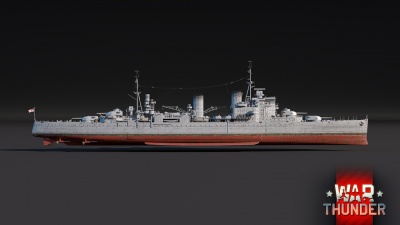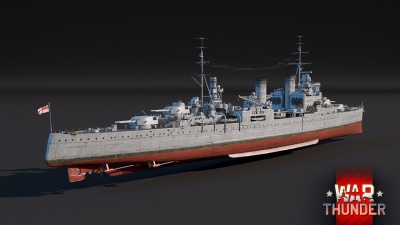HMS London
Contents
- 1 Description
- 2 General info
- 3 Armament
- 4 Usage in battles
- 5 History
- 5.1 The Treaty Cruiser
- 5.2 The 1930s
- 5.3 1939-1941: Reconstruction, Hunt for Bismarck, and all the troubles.
- 5.4 The Strain in the North, The Disaster of PQ17, and the rest of 1942
- 5.5 Use
- 5.6 Examples of use
- 5.7 Use
- 5.8 Examples of use
- 5.9 Use
- 5.10 Examples of use
- 5.11 1943
- 5.12 Way to the East, 1944
- 5.13 1945
- 5.14 After the war
- 5.15 Devblog
- 6 Media
- 7 See also
- 8 External links
Description
The County-class, HMS London (69), 1945 is a rank IV British heavy cruiser with a battle rating of 5.7 (AB/RB/SB). It was introduced in Update 1.97 "Viking Fury".
General info
Survivability and armour
Talk about the vehicle's armour. Note the most well-defended and most vulnerable zones, e.g. the ammo magazine. Evaluate the composition of components and assemblies responsible for movement and manoeuvrability. Evaluate the survivability of the primary and secondary armaments separately. Don't forget to mention the size of the crew, which plays an important role in fleet mechanics. Save tips on preserving survivability for the "Usage in battles" section. If necessary, use a graphical template to show the most well-protected or most vulnerable points in the armour.
Mobility
Write about the ship's mobility. Evaluate its power and manoeuvrability, rudder rerouting speed, stopping speed at full tilt, with its maximum forward and reverse speed.
| Mobility Characteristics | |||
|---|---|---|---|
| Game Mode | Upgrade Status | Maximum Speed (km/h) | |
| Forward | Reverse | ||
| AB | |||
| Upgraded | 70 | 29 | |
| RB/SB | |||
| Upgraded | 60 | 25 | |
Modifications and economy
Armament
Primary armament
Provide information about the characteristics of the primary armament. Evaluate their efficacy in battle based on their reload speed, ballistics and the capacity of their shells. Add a link to the main article about the weapon: {{main|Weapon name (calibre)}}. Broadly describe the ammunition available for the primary armament, and provide recommendations on how to use it and which ammunition to choose.
Secondary armament
Some ships are fitted with weapons of various calibres. Secondary armaments are defined as weapons chosen with the control Select secondary weapon. Evaluate the secondary armaments and give advice on how to use them. Describe the ammunition available for the secondary armament. Provide recommendations on how to use them and which ammunition to choose. Remember that any anti-air armament, even heavy calibre weapons, belong in the next section. If there is no secondary armament, remove this section.
Anti-aircraft armament
An important part of the ship's armament responsible for air defence. Anti-aircraft armament is defined by the weapon chosen with the control Select anti-aircraft weapons. Talk about the ship's anti-air cannons and machine guns, the number of guns and their positions, their effective range, and about their overall effectiveness – including against surface targets. If there are no anti-aircraft armaments, remove this section.
Additional armament
Describe the available additional armaments of the ship: depth charges, mines, torpedoes. Talk about their positions, available ammunition and launch features such as dead zones of torpedoes. If there is no additional armament, remove this section.
Usage in battles
Describe the technique of using this ship, the characteristics of her use in a team and tips on strategy. Abstain from writing an entire guide – don't try to provide a single point of view, but give the reader food for thought. Talk about the most dangerous opponents for this vehicle and provide recommendations on fighting them. If necessary, note the specifics of playing with this vehicle in various modes (AB, RB, SB).
Pros and cons
Pros:
- Very effective anti-air defences
- 8 inch guns are useful for sinking cruisers and destroyers
- Ammunition is stored under the water line and is well protected
- Carries torpedoes which are useful in close range encounters
- Decent speed for a heavy cruiser
Cons:
- Guns lack AP shells to deal with battlecruisers and battleships
- No bridge protection, losing control is very common in this ship
- Lacks deck armour against plunging shells
- Armour is weak against battleship-calibre guns
- Outgunned by battleships, battlecruisers, and some American heavy cruisers
History
The Treaty Cruiser
The County class, named after regional areas of Great Britain, was the largest and most heavy cruiser of the Royal Navy. Under the 1924 Washington treaty limits, they had a standard load under 10,000 tons and four twin-turret with eight pieces of 8 inches (203mm) guns in total. Limited by the regulation, the County class has little protection on the main belt with only 1-inch (25mm) but a completed armor box (1-4inch) covering the magazine parts. The 8" gun was new to the Royal Navy; it had a high muzzle velocity of 3150 ft/sec (960 m/s) and a range of 20 miles (32 km). It was a very accurate gun and was the smallest gun in the RN to require mechanical handling of the shell and charge - the shell weighed 256 lbs. (116 kg). The guns could elevate to 65° and under director control could sustain a firing rate of 4 rounds per minute (Brown, 2012).
Considering the operating environment in remote stations and the duty of being a quick reaction force in hot zones, they had significant autonomy and a large hull for overseas consistency and stability in bad weathers, as well as comfort equipment like air conditioning for tropical areas.
Ordered in 1925, the HMS London laid down in 22nd February 1926, launched 14th September the year after and completed 5th February 1929 in Portsmouth, was the first of the second-group County Class Heavy Cruisers of. Installed engines made by Fairfield Shipbuilders, she was built by the engineers from Newcastle-upon-Tyne.
Compared to the first block, the Kent class, London class removed a protective bulge on the waterline, which forced a modified hull design that increased length by two feet eight inches and incorporated internal bulges for torpedo protection. Besides, the command superstructure was moved further back and lengthened funnels to prevent interference from smoke.
The 1930s
Entered the service in early 1929, HMS London was sent to the Mediterranean, where she became the flagship of the First Cruiser Squadron and activated until March 1939. Her first noticeable task is to quell the uprising on Cyprus in 1931. British had administered the island since 1878, and gave the status of a crown colony in 1925. However, that status irritated the Greek Cypriots who seek for an eventual union with Greece (Klapsis, 2009).
In 1931, the local administration decided to rise tax for covering a local budget deficit, which triggered a severe reaction among Greek Cypriots. On 21 October, more than 5000 Greek Cypriots rallied on the island. They stripped the British flag, besieged Government House and burned it.
The Royal Navy was asked to aid the civil powers. HMS London and her sister ship HMS Shropshire with two destroyers, were sent to suppress the uprising. On 24 October, London landed groups of Royal Marines and armed sailors to protect government offices. The protestors hurled verbal abuse at London's marines and matelots, waving the Greek flag in their faces and throwing stones at Englishmen; to make the marines and sailors lose their cool and open fire in hoping Greece might intervene militarily. But the British held fire. On 25 October, with the arrest of revolt leaders, the protester gradually steams out in the following days, marking a successful end of London's first mission.
On 18 July 1936, the Fascist General Franco led an uprising by twelve military garrisons on mainland Spain, and five in Spanish Morocco ignited the Spanish Civil War. The Royal Navy was involved from the beginning of the conflict. Soon after the war had started, HMS London with her sister ship Devonshire was on station at Gibraltar. On 22 July, London was tasked to evacuate British civilians in Barcelona, where had been a core of conflicts as the ship received reports from ashore saying the city was now quiet after savage fighting. '…one regiment of Fascists was annihilated in a square, being mown down by concealed rifle fire' (Ballantyne. 2002).
London stayed at Barcelona until 22 August when HMS Shropshire replace her role for evacuation. During the period, more than 1800 civilians were evacuated via HMS London. After that, London received a refit in Portsmouth in November, during which four extra high-angle 4-cinh guns were applied on her. At the end of 1936, HMS London was tasked with hunting down gunrunners in Western Mediterranean. Although her aircraft found a suspicious-looking vessel that might be a gunrunner, the cruiser failed to caught it. In 1937, London was called back to Britain in celebration for the coronation of King George VI.
1939-1941: Reconstruction, Hunt for Bismarck, and all the troubles.
With war clouds gathering fast in the late 1930s and naval construction restrictions being discarded equally rapidly, the Admiralty decided to reconstruct the County Class cruisers for better preparations in future combat. HMS London was the first and only one of the County class to rebuild and modernize completely. She entered Chatham in March 1939, and the rebuild proved complex and lasted until February 1941.
Significant modifications were added during the reconstruction. A new 4-inch (102mm) armor belt was added to the waterline to cover the machinery spaces. A series of radars, including Type 279 for air warning and Type 284/285 for fire control. Most notably, a brand-new enlarged superstructure with aircraft hangars replaced the original command tower to provide more space and comfort for operations in bad weather. The newly added superstructure also changed the arrangement of funnels from three to only two. Besides, two twin high-angle 4-inch guns and additional 2-pounder AA guns were added to the ship. The significant increase in displacement after modernization resulted in increased structural stresses in a hull. During subsequent service, these stresses, together with the harsh serving environment in the Arctic, were most likely to have been the cause of the leakages in fuel and feed water systems during later service.
During the reconstruction, German bombers targeted Chatham frequently, and air raids often interrupted the work, delaying London's progress. The cruiser was finally commissioned for service with the Home Fleet on 7 February 1941.
On 5 March, HMS London left Chatham, heading north to join the Home Fleet in Scapa. After arriving at Scapa, London participated in fleet exercises for practicing main guns/sub guns, air defense tanning, and testing new radar equipment. London also played a role as a simulated cruiser target for battleships of Home Fleet.
On 2 April, the London left Scapa with the carrier HMS Argus, which was being used to transport fighter planes to the Mediterranean. The cruiser escorted Argus to a position near Gibraltar, where she handed the duty to HMS Sheffield from Force H.
Returned to Scapa, HMS London spent some time with the battleship King George V keeping watch on Brest to prevent the breakout from German battlecruisers Scharnhorst and Gneisenau. The two German ships had stayed in French since February 1941 and would be there for another year. London's next mission was escorting slow convoys out of Sierra Leone, during which she had to conduct circle movements around the six-knot merchant ship to adapt to their slow speed.
On 12 May, London carried 600 Army soldiers from England to Gibraltar. The consistent high-speed and enough space making the cruiser an ideal ship for transportation, which would conduct more in the rest of the War. After offloading her passengers at Gibraltar, London stayed in port for a few days, as she was due to return to Britain carrying soldiers going home on leave. Together with the cruiser HMS Edinburgh, she provided escort for a UK-bound convoy, carrying evacuees from Gibraltar. During her time in Gibraltar, Italian aircraft tried to bomb the port but missed. London's AA guns went to engagement, but the planes were too far away to shoot down. Sailing north from Gibraltar on 23 May, London encountered a Vichy French ship that she stopped and searched.
Shortly before 5 P.M., on 24 May, London received an immediate order to take over shadowing duties, searching the German battleship Bismarck, which was cornered and destroyed on 27 May, leaving HMS London re-ordered to search German supply ships in the central and southern Atlantic.
On 31 May, HMS London called in at Bathurst, Gambia, to land some of the troops embarked at Gibraltar. HMS London sailed again that afternoon, heading for hunting on German supply ships. On 4 June at 07° 35' N – 31° 29' W, London found the German supply ship Esso Hamburg, the 17,000 tons replenishment oiler, which had refueled the Prinz Eugen morning of 28 May. On 5 June, HMS London found another supply ship, Egerland, flying the Panamanian flag. To prevent her from scuttling herself, London opened fire on her at a very long range set the German ship on fire. The German vessel's crew set scuttling charges and abandoned ship, with several more boatloads of Germans taken aboard the already crowded London.
After receiving enough POWs through the way, HMS London headed to Sierra Leone to offload her passengers, and for part of the way, she helped escort a convoy heading in the same direction. London left the convoy on 7 June and went ahead.
On 6 July, HMS London left Sierra Leone and four days later came across another Vichy French merchant ship that was boarded and searched. On 24 July, London was suddenly called back to England from Gibraltar for searching for a new German raider in North Atlantic. Soon, London was deployed to Iceland for further operation.
The high seas raider alert proved to be a false alarm and, after loitering off Iceland for a short while, London came down to Scapa Flow, arriving on 23 July. In the following two months, London was assigned to multiple convoys escorting missions near Home waters until 22 September, when London was selected for VIP transport. Her mission was to carry a group of American & British government officials, military persons, and business tycoons to Archangel in the far north of Russia for discussing the Lend-Lease agreement and other cooperation in the War.
Covered by the bad weather in the Arctic region, London maintained a high speed on her way to Russia to prevent reconnaissance or attacks from German U-boats and Luftwaffe. HMS London deposited her precious cargo at Archangel on 27 September. To hide from being bombed, London left Archangel on 28 September and waiting for diplomats to back. During this time, she escorted a UK-bound convoy, which was the first Arctic convoy journey of the war. On 2 October, London returned to Archangel for picking up VIPs.
The Strain in the North, The Disaster of PQ17, and the rest of 1942
HMS London backed to England for another refit from November 1941 to January 1942 to fix the creaks in the upper deck and leaking around the machinery spaces caused by the overweight from the reconstruction.
In early February, London completed her refit, and she sailed for Iceland, from where she would conduct multiple “Patrol White,” which refers to a series of patrols for preventing German raiders in the northern area, typically the Denmark Strait and the Norwegian Sea. For London, it would mean many months in the Arctic. The combination of endlessly severe wind, gale-whipped waves, and extremely low temperature created a difficult environment in the Arctic and pushed London and her crews to their limits. Even with her high freeboard, the icing on the upper deck and superstructure is still a usual sight in the Patrol White.
In mid-February, HMS London became the flagship of the First Cruiser Squadron, including her sister ship HMS Norfolk, the only two available heavy cruisers remained in Home Fleet. The expanded scale of war meant the Royal Navy had to dispatch the already depleted fleet to the Far East while the new ships were still under construction. Luckily. At that time, the US Navy Task Force 39.1, including battleship USS Washington, two heavy cruisers, and a flotilla of destroyers, joined the escort for arctic convey to relieve the British. At that moment, Anglo-American naval operations were frequently mounted to sink the German battleship, Tirpitz.
On 7 March, London returned to Iceland from a Patrol White for refueling but immediately put to sea under urgent orders of the Admiralty, traveling all night at high speed on action station as German Battleship Tirpitz left Trondheim and headed north early that day for finding convoy PQ12. In the following day, London joined the strike force with the aircraft carrier HMS Victorious, which launched a wave of torpedo bombers to Tirpitz. Unfortunately, none of the torpedoes caused damage to the German battleship. Tirpitz was able to seek refuge in the Vestfjord unharmed. London kept patrolling in the Norwegian Sea until early April when she returned Scapa for supply and fueling.
On 28th April, HMS made a sortie from Scapa to cover the convoy PQ15 and QP11, together with HMS KGV, HMS Nigeria, HMS Victorious, USS Washington, USS Wichita and USS Tuscaloosa alongside some destroyers. The Home Fleet Task Force sail along the convoy between Norway and Iceland: London and three other cruisers closely around the merchant ships, while the battleships guard in the distance for Germany warships.
On April 29, the pocket battleship Admiral Scheer was reported to be at sea, but she turned around without attacking the convoy. On the following day, the Luftwaffe's bombers attacked the convey. London provided air defense with both her main gun and secondary. Luftwaffe continued the attack on May 1, and the cruisers provide essential air defense for the convey. London, in particular with her radar guiding high angle 4-inch guns, claimed shooting down six Ju88s.
HMS London was back at Scapa Flow by May 5 and nothing much happened for the following nine days until May 14, when London left Scapa with battleship Duke of York, aircraft carrier Victorious, and a flotilla of destroyers in an attempt to rescue cruiser HMS Trinidad, which was badly damaged by the German bomber on her way to Russia. After emergency repairs in Murmansk, Trinidad headed for the Scapa on May 13, accompanied by four destroyers. However, German aircraft spotted Trinidad late in the evening of May 14 and demobilize Trinidad in the following strike. The ship was abandoned and sunk by escorting destroyers on May 15.
On June 27, HMS London, alongside HMS Norfolk, USS Tuscaloosa, and USS Wichita, participated in the escort of the PQ17 convoy from Iceland. Similar to the PQ15, the cruisers provided close-range escorts for the convey. The cruisers were five miles in front, zig-zagging to reduce the risk of being hit by torpedoes. By July 1, although London and other cruisers sent their aircraft for anti-submarine patrol, the convoy was spotted by a U-boat. The Germans were planning a combined offensive involving U-boats, bombers, and surface units. On July 3, battleship Tirpitz and heavy cruiser Admiral Hipper sortied from Altenfjord, pocket battleship Scheer and Lützow sortied in the far north of Norway.
Meanwhile, PQ17 was under attack from bombers and U-boats. In the early hours of July 4, a single plane shot out of a fog bank and dropped its fish, hitting a cargo vessel and damaging her so badly she had to be scuttled. Later the same day, a group of torpedo-bombers attacked and sank another merchant ship. Just under an hour later, more than thirty German aircraft attacked the convey again. Several were shot down, but two more ships were damaged. London contributed to the air defense with her AA guns, helping to disrupt torpedo bombers.
By the evening of July 4, the Admiralty was confident that Tirpitz was in the Altenfjord. The increasing volume of German signals traffic seemed to indicate that something was about to happen. In the early hours of July 4, the Admiralty had advised the London, the flagship of cruisers, that stay with the convoy until it was level with North Cape (25° East).
At the Admiralty in London, the latest deciphered German signals revealed the German had mistaken HMS London for a King George V Class battleship, sailing in company with three escorting destroyers. Because of her rebuild superstructure and the relatively huge hull, London's silhouette was different from any other British cruisers. The foggy weather also made it hard for the scout plane to correctly identify HMS London. The presence of British battleships or aircraft carriers certainly created cautions to Germans. As in the example of PQ12, the airstrike from HMS Victorious halted the engagement of Tirpitz. However, In the Admiralty’s view, if the convoy continued on its way, it would be harassed by enemy U-boats and aircraft. Any enemy heavy ships would most likely be encountered east of North Cape, where beyond the effective range of Home Fleet. The enemy would need no more than ten hours to reach the convoy, and could return to safety in less than that time. Hence, the decision was made to scatter the convoy, with the intention of minimizing the greater losses anticipated from a surface attack compared with those inflicted by U-boats and aircraft (Vego, 2016).
In the evening of July 4, the Admiralty sent orders to Admiral Hamilton, who was in charge of First Cruiser Squadron on HMS London.
At 9:11 p.m. on the cruiser's bridge, the first signal arrived. Marked 'MOST IMMEDIATE', it said:
The Quote template is used to highlight quotes in a text.
Use
{{Quote
|Quote text
|Source, author (optional parameter)
}}
Examples of use
|
There’s no harm in hoping for the best as long as you’re prepared for the worst. <...>
|
Twelve minutes later, another equally alarming signal hit the HMS London:
The Quote template is used to highlight quotes in a text.
Use
{{Quote
|Quote text
|Source, author (optional parameter)
}}
Examples of use
|
There’s no harm in hoping for the best as long as you’re prepared for the worst. <...>
|
This was followed, at 9.36 p.m., by the signal that has gone down as one of the most notorious in naval history:
The Quote template is used to highlight quotes in a text.
Use
{{Quote
|Quote text
|Source, author (optional parameter)
}}
Examples of use
|
There’s no harm in hoping for the best as long as you’re prepared for the worst. <...>
|
On the night of 4 July, HMS London and the other warships sped away from the dismissing convoy. The destroyers and cruisers continued a nightmare dash at high speed through the fog and a sea scattered with icebergs. As the cruisers and destroyers sped on, the communicators in London read with mounting horror the signals from PQ17 merchant ships as they were ripped apart by aircraft and U-boats. Captain of HMS London offered to go back, but Rear Admiral Hamilton reminded him that his ships were low on oil and had lost their fuel ship somewhere in the scattered convoy. (Ballantyne. 2002, p.182-203).
The rest is an absolute disaster for the convey. On 5 July, 14 of 34 merchant ships were sunk or demobilized by air strikes and U-boats. In the following week, nine more merchantmen were sunk or abandoned. Ultimately only eleven merchant ships reached their intended destination – two British, seven American, and the two Russians. The destruction of PQ17 triggered a series of consequences in all aspects. For the Royal Navy, the arctic convoy was held until September when a new tactic was planned for escorting convey.
HMS London returned to Scapa on 8 July and stayed there until September 1942 when the arctic conveys was restarted, then she moved to Hvafjord. The London had departed Hvalfjord on 14 September in company with Norfolk, Sussex, Cumberland, and Sheffield, together with destroyers to escort the convoy PQ18. The British cruiser force patrolled between Bear Island and Spitzbergen, coming to within 700 miles of the North Pole.
PQ18 suffered ten out of forty merchant vessels sunk while QP14, coming the other way, lost three out of fifteen supply ships. Two British warships were also lost. At the same time, the Germans paid a high price, losing forty aircraft and three U-boats. After that, HMS London provided covers for QP15, a convey returning to UK.
1943
HMS London kept on her station in the arctic area until November 17th, when she returned Scapa and was nominated for refit in Tyne shipyard. She sailed up the Tyne to Middle Dock at North Shields for another refit. The refit lasted five months and involved considerable strengthening for cracks and repairing leaks of oil tanks. A new surface warning radar, Type 273, and fire control radar, Type 282, for 40mms were added. The cruiser's aircraft launch gear was removed, and seven additional 20-mm cannons (eight single 20-mm cannons had been fitted during the previous refit, in place of her machine guns). By May 4th, 1943, HMS London was back at Scapa Flow and on sea trials before resuming convoy escort work and patrols in the Denmark Strait.
The London spent some time in Scapa for training. In early July, she was deployed with HMS Belfast and HMS Kent with destroyers in diversionary moves around Norway to distract attention away from the Allied landings in Sicily by reinforcing Hitler's fear about an invasion of Norway. Around the same time, London took part in Operation Holder, conveying supplies, personnel, and mail to Royal Navy bases in north Russia. On July 9th, London returned to Scapa and resumed interception duties to prevent the breakout of German warships for attacks on Atlantic convey in the following months.
In October 1943, HMS London was sent on a special mission to waters around the island of Spitzbergen, far to the north of Iceland, where it was suspected the Germans were maintaining a secret radio intercept station. The cruiser sailed around the island but failed to find any such station.
Late in the same month, the cruiser helped escort a convey of five US-built minesweepers and six metal hulled motor launches to Murmansk. For London, service in the Arctic was coming to a close as she was about to receive orders for another diplomatic mission, this time carrying members of the Prime Minister's staff to Egypt. In early November, she was tasked to Plymouth to pick up the mission members, ending London's memory in the Arctic.
Arriving at Plymouth on 10 November, HMS London carried members of the Prime Minister's staff, while Churchill himself sailed to Egypt for the Cairo conference in the battlecruiser HMS Renown. London also loaded the 'Stalingrad Sword,' a gift from King George VI to the people of Stalingrad that celebrated the great victory over the Germans. It had been carried from Plymouth to Egypt by HMS London before being put on the plane with the British delegation.
The London stayed at Alexandria during the Cairo conference, and in early December, set out on the journey home carrying VIP passengers. Arriving at Gibraltar on 13 December, London left for the UK four days later for troop transportation. On 21 December, she arrived in the Clyde, disembarked her passengers, and two days later sailed for Rosyth to undergo another refit, during which four twin 20mm guns were fitted to reinforce the AA defense.
Way to the East, 1944
In early February 1944, HMS London was back on the Clyde for mail and new drafts of sailors. By then, the Admiralty had decided to deploy her for service in Eastern Fleet. On March 13th, London arrived at Colombo, one of the two major British naval bases in Ceylon, and, four days later, transferred to the other, Trincomalee.
On March 21th, as a member of the British fleet, London participated in Operation Diplomat, which was a naval training operation between Royal Navy and US Navy. The operations aimed to practice operational procedures and tactics that the British Pacific fleet would use. On March 27th, London met the US Task Group 58.5. In the following month, London was assigned to Task Force 70 for Air Rescue duty for aircraft carriers. On April 19th, the task force attacked the island of Sabang with no serious opposition from the Japanese. London provided close covers to carriers during attacks on Sabang. On April 24th, the Task Force returned to Trincomalee for resupply.
On April 30th, HMS London was assigned to Task Force 67 with her sister ship HMS Suffolk. The fleet sailed to Exmouth Bay, Western Australia, for Operation Transom, an air raid marking the return of the British fleet in the Pacific. London was reassigned to Task Force 66 on May 15th to provide escorts for aircraft carriers during the airstrike on the Japanese-held Surabaya. She accompanied British aircraft carriers for the rest of May until they returned Trincomalee.
On September 12th, after a period of fleet exercises, London arrived at Bombay, where she entered dry dock for bottom cleaning and essential maintenance. Thirteen days later, London left Bombay, carried out some gunnery practice, and headed for Ceylon. She was to join Task Group 63.2 to escort aircraft carrier for a bombardment mission in mid-October against Car Nicobar in the Nicobar Islands, north of Sumatra. London contributed to air defense on October 19th, when the fleet shot down seven Japanese torpedo bombers in total.
1945
In early 1945, HMS London provided convey escorts in the Indian ocean. On April 8th, 1945, London joined the British East Indies Fleet's Task Force 63 for another bombardment mission. The warships were left in two groups, with London in Group One alongside HMS Queen Elizabeth, the French battleship Richelieu and destroyers. Group Two included the escort carriers Khedive and Emperor, the cruiser Cumberland and the destroyers Virago and Venus.
On April 11th, London and battleships carried out a bombardment on coastal artillery at Sabang. In the following week, London provided close escorts for carrier operations until TF63 returned to Trincomalee on April 18th.
On May 13th, the London set sail for Simonstown naval base in South Africa where she was dry-docked for a refit, in which a barrage fire control radar (Type283) and new surface warning radar (Type277) were added on the ship. HMS London returned to her duty in early August of 1945, preparing for an amphibious assault in southern Malaya. But the operation was canceled on August 15th, just at the same time when Japan surrendered. After Japan surrendered, on August 28th, HMS London arrived in Sabang to disarm the local Japanese garrison and received charts of the Japanese minefields off Malaya and Singapore from the Japanese delegation.
On 14 October, at Colombo, London embarked around 400 passengers and 200 bags of mail and the following morning set sail for home, arriving at Sheerness three weeks later. By 9 November, HMS London returned her home at Chatham marking the end of her story in WWII.
The London might have come through the Second World War unscathed and unnoticed, but ahead lay her sternest test under fire and it would make headlines around the world.
After the war
Prior to joining the Royal Navy Reserve, the HMS London was used as Troop Transport from UK to Colombo (26 Nov 1945), Sydney (19 Jan 1946) and after a brief refit in Devonport, to Singapore (May 1946). She returned to Plymouth in late June that year.
But by the end of 1946, London was refitted for further service in the Far East as she was the only modernized 8-inch gun cruiser in Royal Navy. The refit was completed in 1947. After working up, the cruiser joined the 5th Cruiser Squadron at Royal Navy China Station in Hong Kong to protect British interests and civilians in the Eastern waters.
During her final deployment, the most notable event was the attempt to rescue HM Sloop Amethyst, or Yangtze Incident, from 20 April to 21 April 1949.
After World War Two, a Chinese civil war broke out between the nationalists led by Chiang Kai Shek were bitter enemies of the Communists led by Mao Tse Tung. By mid-April 1948, the Communists were a short distance from Nanking, which was the capital of the Nationalist Government, and were building up forces to cross the Yangtze River. To demonstrate protection for British subjects in Chinese waters, the Royal Navy was asked to maintain at least one large ship (cruiser size) with two smaller ships in Shanghai and one small ship at Nanking.
In 1949 17th, London sailed from Hong Kong to Shanghai. At that time, frigates Amethyst and Black Swan were stationed at Shanghai and destroyer Consort at Nanking. The Naval Attaché at Nanking advised the Communist army to cross the Yangtze River on 21 April, and British ships should avoid any involvement. On 20 April, Amethyst came to relieve Consort at Nanking, and at 9:30 a.m., Amethyst was under artillery fire from the north bank. The frigate’s bridge and machinery room were hit by shells, causing the frigate to lose control and beached on Rose Island (Hughes, 1979).
On 20 April, HMS London, flying the flag of Vice-Admiral Madden, was approaching the mouth of the Yangtze River bound for Shanghai on a flag-showing visit. During the forenoon, London was receiving information from Amethyst that she was attacked by unexpected fire and demobilized. The Admiral ordered the frigate, Black Swan, to join London and decided to weigh on 21 April and proceed upriver with Black Swan to rescue Amethyst.
In the early morning of the following day, London and Black Swan weighed to move upriver. The British ships anchored off at 8:00 a.m., as Amethyst managed to move out of Rose Island. Admiral Madden called Amethyst to rejoin the fleet. But, due to the death of the navigator and damage to charts, Amethyst was unable to set the correct heading. In this case, London and Black Swan weighed again at 10:26 a.m. and moved up the river. In less than a few minutes, the Communist opened fire at London and Black Swan with large-caliber howitzers and small-caliber cannons. London counterattacked with her main guns and secondary armaments. The large-caliber batteries were easy to spot and destroy, while smaller caliber weapons were well concealed and difficult to hit. At some time before 11:00 a.m., a howitzer shell hit the bridge, injuring the Captain. At that time, considering the low possibility of escorting Amethyst under heavy fire and increasing damage on the ship, Admiral Madden decided to withdraw at 11:04 a.m. London and Black Swan turned back and arrived in Shanghai later that day.
London had been under fire for 48 minutes in an overall period of 3 hours (Dalrymple, 2011). In that period, London fired 155 rounds of 8-inch, 449 rounds of 4-inch, and more than 2600 small caliber AA guns. Among London’s crew, 13 people are dead and 59 people wounded, of whom two died later. Amethyst would make her escape in three months.
After some temporary repairs in Shanghai, HMS London departed on 14 June, heading south to Singapore, where she spent a few weeks. On 18 June, London left Singapore and on her way to the UK. She arrived in Chatham on 8 September. By the end of 1949, she received an inspection to determine if she could serve further after an overall refit. However, London's aging machinery and construction meant it would be too expensive to keep in service. She was placed on the Disposal List and laid up at Falmouth before sale to BISCO for demolition by T W Ward on 3 January 1950. The ship went to Barrow-in-Furness under tow and arrived at the breaker’s yard on 22 January, Work on demolition was completed later that year.
Devblog
The County-class cruisers, also known as the A-Type cruisers, were the first British cruiser vessels to be developed in the interwar period of the 1920s. Their design being heavily influenced by the restrictions imposed by the Washington Naval Treaty, meant that British shipbuilders had to find compromises during development in order to comply with the treaty as well as to meet the requirements of the Royal Navy for a ship capable of trade route protection.
This resulted in the creation of a ship design with good cruising range and adequate firepower, but very light armour protection in order to stay within treaty restrictions. The orders for the first ships were placed in the mid 1920’s and construction began in 1924.
HMS London (C69) was laid down in February 1926 and commissioned into service in January 1929 as the lead ship of the second batch of County-class cruisers to be built, known as the London subclass. During the 1930’s, HMS London took part in a goodwill visit to Venice and assisted in the evacuation of civilians from Barcelona during the Spanish Civil War, before being sent to drydock for refit in 1939.
In 1941, HMS London took part in the hunt for the battleship Bismarck, after which the ship was once again dry-docked for repairs. The following year, HMS London assisted in escorting several convoys in the Atlantic, after which she was assigned to South African waters in 1943, before joining the Eastern Fleet. HMS London continued serving in the postwar years, during which the ship got involved in an incident in Chinese waters in 1949 which left it heavily damaged. Being deemed uneconomical for repairs, HMS London was sold for scrap in January 1950.
Media
See also
Links to articles on the War Thunder Wiki that you think will be useful for the reader, for example:
- reference to the series of the ship;
- links to approximate analogues of other nations and research trees.
External links
References
Anderson, P. (2019). British Government Maritime Evacuations in the Spanish Civil War, 1936–1939. War in History, 26(1), 65-85.
Ballantyne, I. (2002). HMS London: Warships of the Royal Navy. Casemate Publishers.
Beesly, P. (1990). Convoy PQ 17: A study of intelligence and decision‐making. Intelligence and National Security, 5(2), 292-322.
Churchill, W. (1951). The Second World War-Volume 4: The Hinge of Fate. Rosetta Book LLC.
Brown, D. K. (2012). Nelson to Vanguard: Warship Design and Development 1923 1945. Seaforth Publishing.
Colledge, J. J., & Warlow, B. (2010). Ships of the Royal Navy: The complete record of all fighting ships of the Royal Navy from the 15th century to the present. Casemate/Greenhill.
Dalrymple, Gordon. & Stewart, Neil. (2011). HMS London in the River Yangtze 20 & 21 April 1949. Monograph No.170.
Irving, D. J. C. (1968). The Destruction of Convoy PQ. 17. Cassell.
Klapsis, A. (2009). Between the Hammer and the Anvil. The Cyprus Question and Greek Foreign Policy from the Treaty of Lausanne to the 1931 Revolt.
Hughes, W.R.N..(1979). HMS Amethyst - the Yangtse Incident 1948. Naval Historical Review.
Vego, M. (2016). The Destruction of Convoy PQ17: 27 June–10 July 1942. Naval War College Review, 69(3), 83-142.
Works Cited
- Chen, C. (2007, May). Heavy Cruiser London. Retrieved November 17, 2020, from https://ww2db.com/ship_spec.php?ship_id=326
- Helgason, G. (1995). HMS London (69). Retrieved November 17, 2020, from https://uboat.net/allies/warships/ship/1178.html
| Britain heavy cruisers | |
|---|---|
| Hawkins-class | HMS Hawkins |
| York-class | HMS York |
| County-class | HMS Kent · HMS London · HMS Norfolk |


